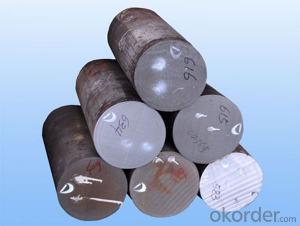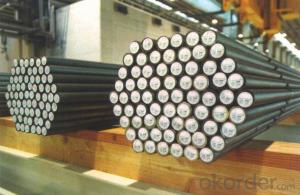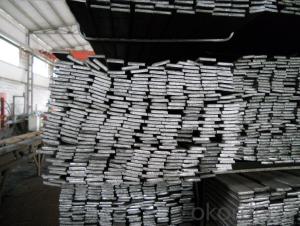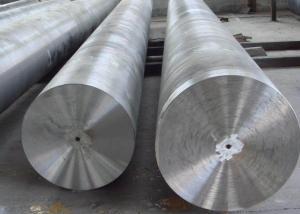Cold Drawn Steel Bars Round Square Rods
- Loading Port:
- China main port
- Payment Terms:
- TT OR LC
- Min Order Qty:
- 30 m.t.
- Supply Capability:
- 10000 m.t./month
OKorder Service Pledge
OKorder Financial Service
You Might Also Like
Specification
Cold Drawn Steel Bars Round Square Rods
Product Information:
1, Standard: GB, ASTM, AISI, SAE, DIN, JIS, EN
2, Produce Process: smelt iron - EAF smelt billet - ESR smelt billet - hot rolled or forged to get the steel round bar and plate
3, Heat Treatment: annealing, normalizing, tempering, quenching
4, Surface Treatment: Black, Polished, Galvanized the picture of the products
5, Quality Assurance: We accept third party inspection for all orders.
You can ask testing organizations such as SGS, BV, etc. to test our products before shipping.
Product Overviews:
| Product Name | Typical Grades | Diameter(mm) | Standard adopted |
| Carbon Steel | 20 (1020/S20C/C22) | Ø16-Ø300 | GB/SAE/JIS/DIN |
| 40 (1040/S40C/C40) | |||
| 45 (1045/S45C/C45) | |||
| Bearing Steel | GCr9 (51100/SUJ1) | Ø12-Ø250 | |
| GCr15 (52100/SUJ2/100Gr6) | |||
| GCr9SiMn (A485-Gr.1/SUJ3) | |||
| Cr-Mo Steel | 20Cr (5120/SCr420H/20Cr4) | Ø12-Ø250 | |
| 40Cr (5140/SCr440/41Cr4) | |||
| 42CrMo(4140/SCM440/42CrMo4) | |||
| Gear Steel | 20CrNiMo | Ø16-Ø600 | |
| 20CrMn(5115/SMnC420/20MnCr5) | |||
| 20CrNiMo(8620/SNCM220/20CrMiMo2) |
Product Show:

Our Advantages:
· Industry experience over 20 years.
· Shipment of goods -More than 70 countries worldwide.
· The most convenient transport and prompt delivery.
· Competitive price with best service.
· High technical production line with top quality products.
· High reputation based on best quality products.
With our experienced, enthusiastic and dynamic staffs, we assure to bring you the products with best quality, reasonable prices and good after-sales services under the motto: Friends First, Business After.
Communication, Experience, Expertise and Best efforts are our Promises to you.
- Q: What are the applications of special steel in the food processing industry?
- Due to its unique properties and characteristics, special steel finds wide-ranging applications in the food processing industry. One significant use of special steel in this sector is for manufacturing equipment and machinery used in food processing plants. Its corrosion resistance and ability to withstand extreme temperatures make it ideal for frequent sanitization and operation under harsh conditions. Special steel is commonly employed in the production of blades, knives, and cutting tools used in food processing. Its high strength and durability enable these tools to maintain their sharpness and effectiveness even after prolonged use, ensuring efficient and precise cutting of food products. Another application of special steel in the food processing industry is for constructing storage tanks and containers. These tanks are utilized for storing and transporting various food products. The corrosion resistance and hygiene properties of special steel prevent contamination and ensure the quality and safety of the stored food. Moreover, special steel is also utilized in the construction of processing machinery, such as mixers, grinders, and extruders. Its high strength and stability enable these machines to handle the rigorous demands of food processing, ensuring smooth operation and minimizing downtime. Furthermore, special steel often finds application in the production of conveyor systems used in food processing facilities. These conveyors play a crucial role in moving food products along the processing line, and special steel's resistance to wear and tear ensures efficient and reliable operation, reducing the risk of product contamination. In conclusion, special steel plays an extensive and crucial role in the food processing industry. Its unique properties contribute significantly to the efficiency, safety, and quality of food processing operations, from equipment manufacturing to storage and processing machinery construction.
- Q: What are the corrosion resistance properties of special steel?
- Special steels are known for their excellent corrosion resistance properties. These steels have specific alloying elements added to enhance their resistance to corrosion, making them highly resistant to rust and various corrosive environments. Their composition and surface treatment provide a protective barrier against chemical reactions, moisture, and other corrosive agents, ensuring their durability and longevity in various applications.
- Q: How is special steel used in the production of cutting blades?
- Special steel is used in the production of cutting blades due to its exceptional hardness, durability, and resistance to wear. This type of steel is specifically designed to withstand the high levels of stress and heat generated during cutting processes. It allows the blades to retain their sharpness for a longer period, resulting in improved cutting performance and longer lifespan. Additionally, special steel can be tailored to meet specific requirements, such as corrosion resistance or high impact strength, making it a preferred choice for various cutting applications.
- Q: How does special steel enhance the durability of products?
- Special steel enhances the durability of products by providing superior strength, hardness, and resistance to wear, corrosion, and extreme temperatures. Its unique composition and manufacturing techniques make it highly efficient in withstanding heavy loads and external factors, thereby ensuring longevity and reliability of the products it is used in.
- Q: What are the main characteristics of electrical steel?
- The main characteristics of electrical steel include high magnetic permeability, low electrical resistivity, and low hysteresis loss. It is specifically designed to efficiently conduct and transform electrical energy, making it ideal for use in transformers, motors, and generators.
- Q: How does special steel contribute to the renewable energy conversion efficiency?
- Special steel plays a crucial role in enhancing the renewable energy conversion efficiency by providing durability, strength, and resistance to extreme conditions. It is used in the construction of wind turbines, solar panels, and hydropower systems, ensuring their reliability and longevity. Moreover, special steel alloys facilitate the development of more efficient and lightweight components, reducing energy losses and optimizing the overall performance of renewable energy systems.
- Q: What are the main characteristics of structural steel?
- The main characteristics of structural steel include high strength, durability, versatility, and cost-effectiveness. It has a high strength-to-weight ratio, allowing for the construction of large and complex structures with minimal material usage. It is also resistant to corrosion and can withstand extreme weather conditions, making it suitable for both indoor and outdoor applications. Additionally, structural steel is highly versatile, as it can be easily fabricated, modified, and reused. Its cost-effectiveness is another key characteristic, as it offers long-term value due to its low maintenance requirements and ability to withstand heavy loads.
- Q: What are the main applications of special steel in the defense equipment?
- Special steel is widely used in defense equipment due to its unique properties. One of the main applications of special steel in defense is for manufacturing armor and ballistic protection, ensuring the safety of military personnel and vehicles in combat. It is also used in the production of military aircraft, submarines, and ships, providing strength, durability, and resistance to extreme conditions. Special steel is further utilized in the production of firearms and ammunition, offering high strength and reliability. Overall, the main applications of special steel in defense equipment revolve around enhancing protection, performance, and longevity in critical military applications.
- Q: How does special steel contribute to reducing product defects during manufacturing?
- Special steel contributes to reducing product defects during manufacturing by offering superior strength, durability, and corrosion resistance properties. This high-quality material ensures that the manufactured products have a lower risk of breakage, wear, or deformation, reducing the likelihood of defects. Additionally, special steel's precise composition and uniformity enable accurate machining and forming processes, resulting in more accurate and consistent product dimensions. Its resistance to heat and pressure also minimizes the occurrence of thermal expansion or distortion, further reducing defects during manufacturing.
- Q: What are the recycling options for special steel?
- Recycling options for special steel typically involve two main processes: reusing and remelting. Special steel, such as stainless steel or alloy steel, can be reused in various industries and applications after undergoing refurbishment and quality checks. If the steel is no longer suitable for reuse, it can be remelted in steel furnaces to produce new steel products while conserving valuable resources and reducing environmental impact.
Send your message to us
Cold Drawn Steel Bars Round Square Rods
- Loading Port:
- China main port
- Payment Terms:
- TT OR LC
- Min Order Qty:
- 30 m.t.
- Supply Capability:
- 10000 m.t./month
OKorder Service Pledge
OKorder Financial Service
Similar products
Hot products
Hot Searches
Related keywords




























